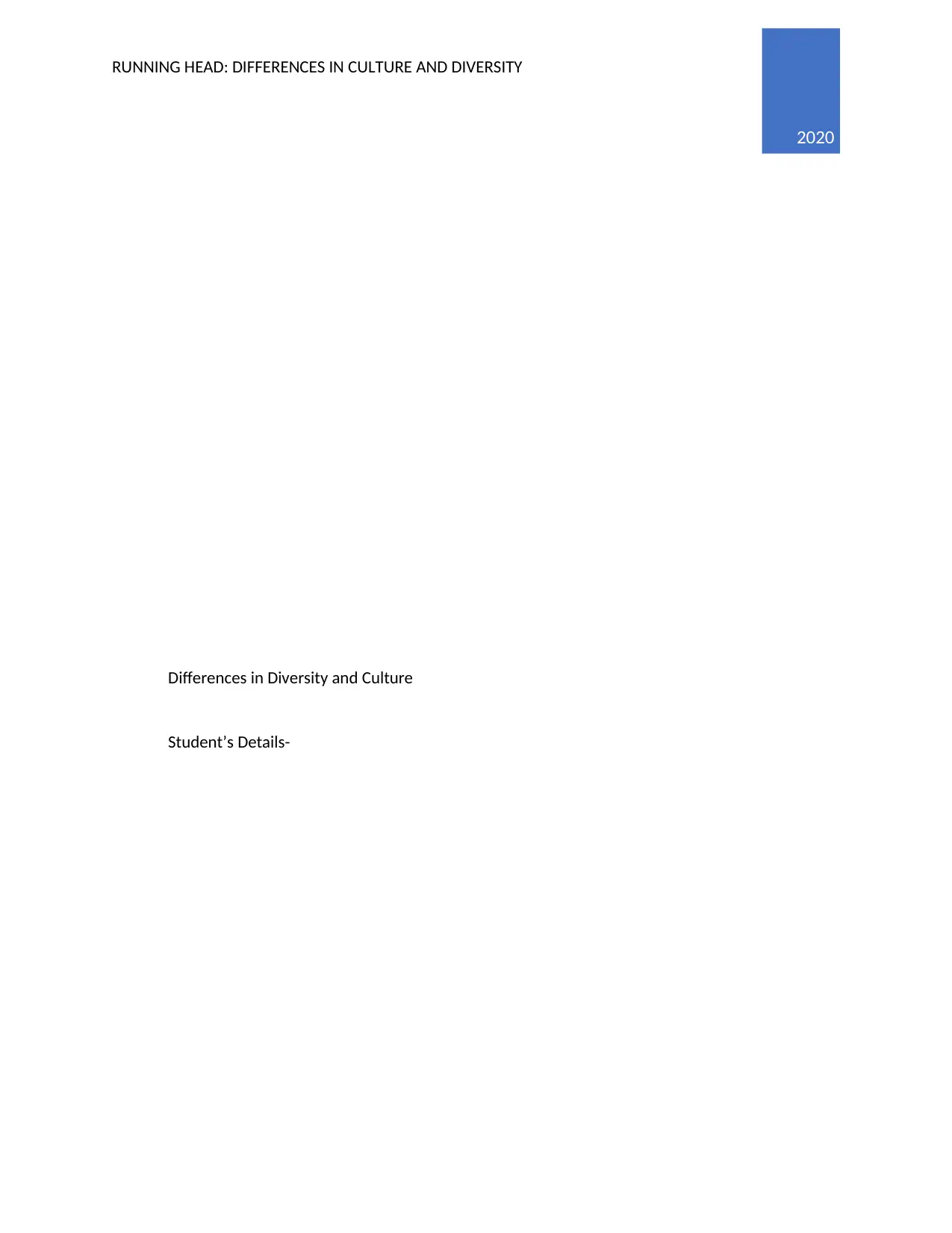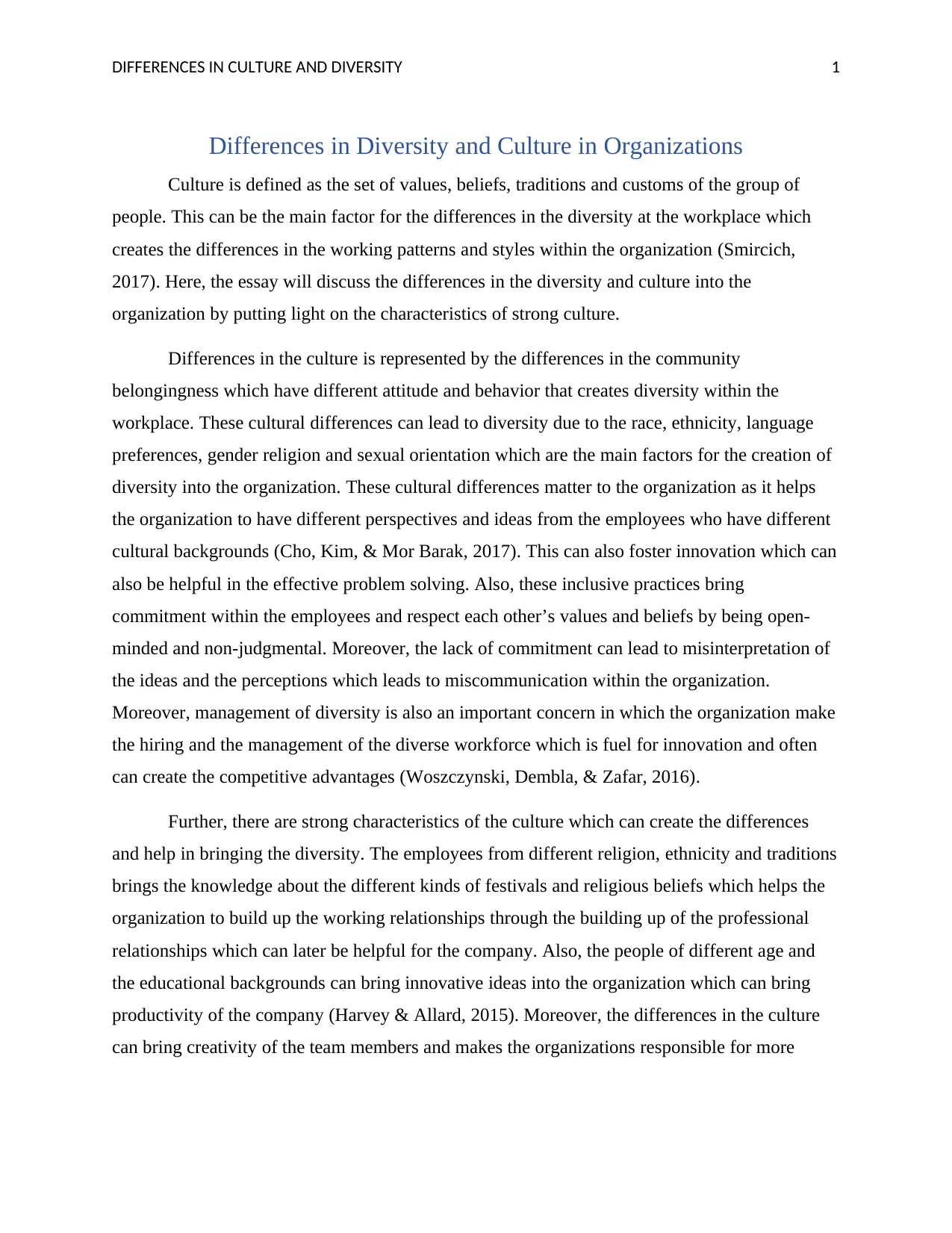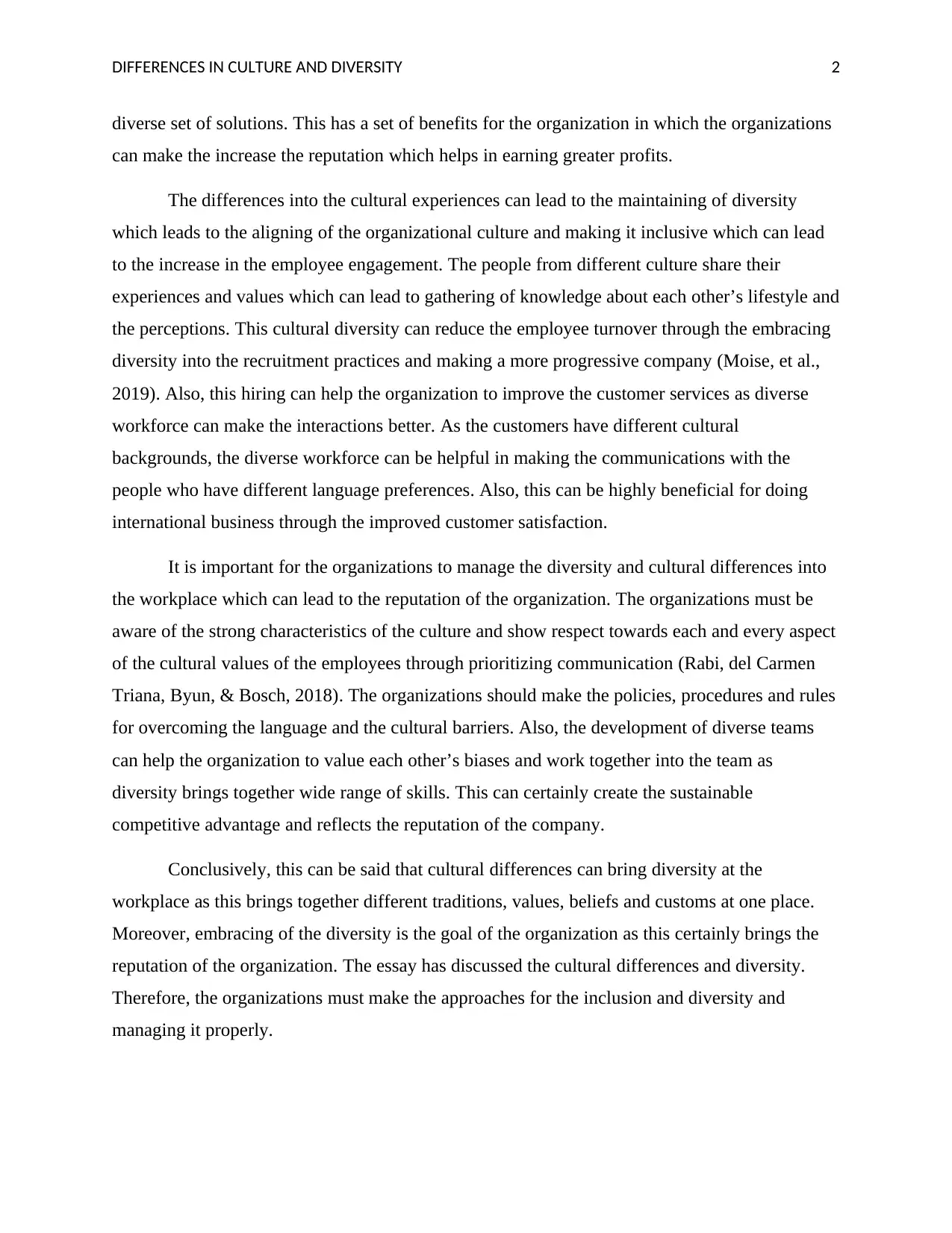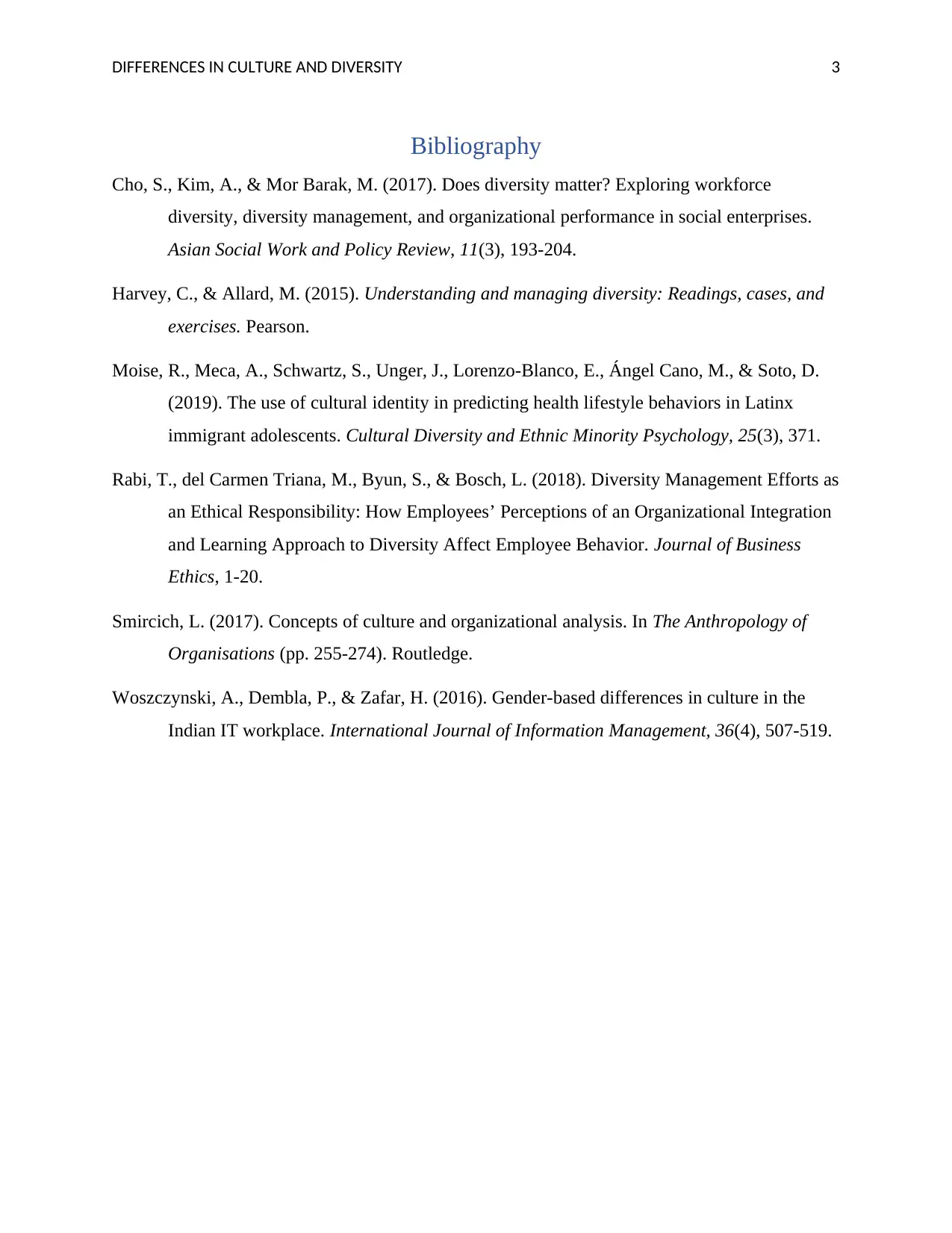Management Essay: Analyzing Cultural Diversity in the Workplace
VerifiedAdded on 2022/09/08
|4
|1127
|15
Essay
AI Summary
This essay examines the significant differences in culture and diversity within organizations, highlighting how cultural variations, including values, beliefs, and customs, impact workplace dynamics. It explores the characteristics of a strong organizational culture and how these influence diversity, encompassing aspects such as race, ethnicity, gender, and religion. The essay emphasizes the importance of managing diversity to foster innovation, improve problem-solving, and enhance employee commitment. It also discusses how cultural differences contribute to different perspectives, innovative ideas, and improved customer service, particularly in international business contexts. The essay concludes by stressing the need for organizations to embrace diversity through inclusive practices, effective communication, and the development of diverse teams to create a sustainable competitive advantage and enhance organizational reputation. The essay also makes a case on how embracing diversity in recruitment practices can reduce employee turnover and improve customer service.

RUNNING HEAD: DIFFERENCES IN CULTURE AND DIVERSITY 0
2020
Differences in Diversity and Culture
Student’s Details-
2020
Differences in Diversity and Culture
Student’s Details-
Paraphrase This Document
Need a fresh take? Get an instant paraphrase of this document with our AI Paraphraser

DIFFERENCES IN CULTURE AND DIVERSITY 1
Differences in Diversity and Culture in Organizations
Culture is defined as the set of values, beliefs, traditions and customs of the group of
people. This can be the main factor for the differences in the diversity at the workplace which
creates the differences in the working patterns and styles within the organization (Smircich,
2017). Here, the essay will discuss the differences in the diversity and culture into the
organization by putting light on the characteristics of strong culture.
Differences in the culture is represented by the differences in the community
belongingness which have different attitude and behavior that creates diversity within the
workplace. These cultural differences can lead to diversity due to the race, ethnicity, language
preferences, gender religion and sexual orientation which are the main factors for the creation of
diversity into the organization. These cultural differences matter to the organization as it helps
the organization to have different perspectives and ideas from the employees who have different
cultural backgrounds (Cho, Kim, & Mor Barak, 2017). This can also foster innovation which can
also be helpful in the effective problem solving. Also, these inclusive practices bring
commitment within the employees and respect each other’s values and beliefs by being open-
minded and non-judgmental. Moreover, the lack of commitment can lead to misinterpretation of
the ideas and the perceptions which leads to miscommunication within the organization.
Moreover, management of diversity is also an important concern in which the organization make
the hiring and the management of the diverse workforce which is fuel for innovation and often
can create the competitive advantages (Woszczynski, Dembla, & Zafar, 2016).
Further, there are strong characteristics of the culture which can create the differences
and help in bringing the diversity. The employees from different religion, ethnicity and traditions
brings the knowledge about the different kinds of festivals and religious beliefs which helps the
organization to build up the working relationships through the building up of the professional
relationships which can later be helpful for the company. Also, the people of different age and
the educational backgrounds can bring innovative ideas into the organization which can bring
productivity of the company (Harvey & Allard, 2015). Moreover, the differences in the culture
can bring creativity of the team members and makes the organizations responsible for more
Differences in Diversity and Culture in Organizations
Culture is defined as the set of values, beliefs, traditions and customs of the group of
people. This can be the main factor for the differences in the diversity at the workplace which
creates the differences in the working patterns and styles within the organization (Smircich,
2017). Here, the essay will discuss the differences in the diversity and culture into the
organization by putting light on the characteristics of strong culture.
Differences in the culture is represented by the differences in the community
belongingness which have different attitude and behavior that creates diversity within the
workplace. These cultural differences can lead to diversity due to the race, ethnicity, language
preferences, gender religion and sexual orientation which are the main factors for the creation of
diversity into the organization. These cultural differences matter to the organization as it helps
the organization to have different perspectives and ideas from the employees who have different
cultural backgrounds (Cho, Kim, & Mor Barak, 2017). This can also foster innovation which can
also be helpful in the effective problem solving. Also, these inclusive practices bring
commitment within the employees and respect each other’s values and beliefs by being open-
minded and non-judgmental. Moreover, the lack of commitment can lead to misinterpretation of
the ideas and the perceptions which leads to miscommunication within the organization.
Moreover, management of diversity is also an important concern in which the organization make
the hiring and the management of the diverse workforce which is fuel for innovation and often
can create the competitive advantages (Woszczynski, Dembla, & Zafar, 2016).
Further, there are strong characteristics of the culture which can create the differences
and help in bringing the diversity. The employees from different religion, ethnicity and traditions
brings the knowledge about the different kinds of festivals and religious beliefs which helps the
organization to build up the working relationships through the building up of the professional
relationships which can later be helpful for the company. Also, the people of different age and
the educational backgrounds can bring innovative ideas into the organization which can bring
productivity of the company (Harvey & Allard, 2015). Moreover, the differences in the culture
can bring creativity of the team members and makes the organizations responsible for more

DIFFERENCES IN CULTURE AND DIVERSITY 2
diverse set of solutions. This has a set of benefits for the organization in which the organizations
can make the increase the reputation which helps in earning greater profits.
The differences into the cultural experiences can lead to the maintaining of diversity
which leads to the aligning of the organizational culture and making it inclusive which can lead
to the increase in the employee engagement. The people from different culture share their
experiences and values which can lead to gathering of knowledge about each other’s lifestyle and
the perceptions. This cultural diversity can reduce the employee turnover through the embracing
diversity into the recruitment practices and making a more progressive company (Moise, et al.,
2019). Also, this hiring can help the organization to improve the customer services as diverse
workforce can make the interactions better. As the customers have different cultural
backgrounds, the diverse workforce can be helpful in making the communications with the
people who have different language preferences. Also, this can be highly beneficial for doing
international business through the improved customer satisfaction.
It is important for the organizations to manage the diversity and cultural differences into
the workplace which can lead to the reputation of the organization. The organizations must be
aware of the strong characteristics of the culture and show respect towards each and every aspect
of the cultural values of the employees through prioritizing communication (Rabi, del Carmen
Triana, Byun, & Bosch, 2018). The organizations should make the policies, procedures and rules
for overcoming the language and the cultural barriers. Also, the development of diverse teams
can help the organization to value each other’s biases and work together into the team as
diversity brings together wide range of skills. This can certainly create the sustainable
competitive advantage and reflects the reputation of the company.
Conclusively, this can be said that cultural differences can bring diversity at the
workplace as this brings together different traditions, values, beliefs and customs at one place.
Moreover, embracing of the diversity is the goal of the organization as this certainly brings the
reputation of the organization. The essay has discussed the cultural differences and diversity.
Therefore, the organizations must make the approaches for the inclusion and diversity and
managing it properly.
diverse set of solutions. This has a set of benefits for the organization in which the organizations
can make the increase the reputation which helps in earning greater profits.
The differences into the cultural experiences can lead to the maintaining of diversity
which leads to the aligning of the organizational culture and making it inclusive which can lead
to the increase in the employee engagement. The people from different culture share their
experiences and values which can lead to gathering of knowledge about each other’s lifestyle and
the perceptions. This cultural diversity can reduce the employee turnover through the embracing
diversity into the recruitment practices and making a more progressive company (Moise, et al.,
2019). Also, this hiring can help the organization to improve the customer services as diverse
workforce can make the interactions better. As the customers have different cultural
backgrounds, the diverse workforce can be helpful in making the communications with the
people who have different language preferences. Also, this can be highly beneficial for doing
international business through the improved customer satisfaction.
It is important for the organizations to manage the diversity and cultural differences into
the workplace which can lead to the reputation of the organization. The organizations must be
aware of the strong characteristics of the culture and show respect towards each and every aspect
of the cultural values of the employees through prioritizing communication (Rabi, del Carmen
Triana, Byun, & Bosch, 2018). The organizations should make the policies, procedures and rules
for overcoming the language and the cultural barriers. Also, the development of diverse teams
can help the organization to value each other’s biases and work together into the team as
diversity brings together wide range of skills. This can certainly create the sustainable
competitive advantage and reflects the reputation of the company.
Conclusively, this can be said that cultural differences can bring diversity at the
workplace as this brings together different traditions, values, beliefs and customs at one place.
Moreover, embracing of the diversity is the goal of the organization as this certainly brings the
reputation of the organization. The essay has discussed the cultural differences and diversity.
Therefore, the organizations must make the approaches for the inclusion and diversity and
managing it properly.
⊘ This is a preview!⊘
Do you want full access?
Subscribe today to unlock all pages.

Trusted by 1+ million students worldwide

DIFFERENCES IN CULTURE AND DIVERSITY 3
Bibliography
Cho, S., Kim, A., & Mor Barak, M. (2017). Does diversity matter? Exploring workforce
diversity, diversity management, and organizational performance in social enterprises.
Asian Social Work and Policy Review, 11(3), 193-204.
Harvey, C., & Allard, M. (2015). Understanding and managing diversity: Readings, cases, and
exercises. Pearson.
Moise, R., Meca, A., Schwartz, S., Unger, J., Lorenzo-Blanco, E., Ángel Cano, M., & Soto, D.
(2019). The use of cultural identity in predicting health lifestyle behaviors in Latinx
immigrant adolescents. Cultural Diversity and Ethnic Minority Psychology, 25(3), 371.
Rabi, T., del Carmen Triana, M., Byun, S., & Bosch, L. (2018). Diversity Management Efforts as
an Ethical Responsibility: How Employees’ Perceptions of an Organizational Integration
and Learning Approach to Diversity Affect Employee Behavior. Journal of Business
Ethics, 1-20.
Smircich, L. (2017). Concepts of culture and organizational analysis. In The Anthropology of
Organisations (pp. 255-274). Routledge.
Woszczynski, A., Dembla, P., & Zafar, H. (2016). Gender-based differences in culture in the
Indian IT workplace. International Journal of Information Management, 36(4), 507-519.
Bibliography
Cho, S., Kim, A., & Mor Barak, M. (2017). Does diversity matter? Exploring workforce
diversity, diversity management, and organizational performance in social enterprises.
Asian Social Work and Policy Review, 11(3), 193-204.
Harvey, C., & Allard, M. (2015). Understanding and managing diversity: Readings, cases, and
exercises. Pearson.
Moise, R., Meca, A., Schwartz, S., Unger, J., Lorenzo-Blanco, E., Ángel Cano, M., & Soto, D.
(2019). The use of cultural identity in predicting health lifestyle behaviors in Latinx
immigrant adolescents. Cultural Diversity and Ethnic Minority Psychology, 25(3), 371.
Rabi, T., del Carmen Triana, M., Byun, S., & Bosch, L. (2018). Diversity Management Efforts as
an Ethical Responsibility: How Employees’ Perceptions of an Organizational Integration
and Learning Approach to Diversity Affect Employee Behavior. Journal of Business
Ethics, 1-20.
Smircich, L. (2017). Concepts of culture and organizational analysis. In The Anthropology of
Organisations (pp. 255-274). Routledge.
Woszczynski, A., Dembla, P., & Zafar, H. (2016). Gender-based differences in culture in the
Indian IT workplace. International Journal of Information Management, 36(4), 507-519.
1 out of 4
Related Documents
Your All-in-One AI-Powered Toolkit for Academic Success.
+13062052269
info@desklib.com
Available 24*7 on WhatsApp / Email
![[object Object]](/_next/static/media/star-bottom.7253800d.svg)
Unlock your academic potential
Copyright © 2020–2025 A2Z Services. All Rights Reserved. Developed and managed by ZUCOL.



